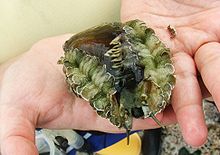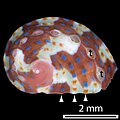Haliotis asinina
| Haliotis asinina Temporal range:
| |
|---|---|

| |
| A living specimen of Haliotis asinina | |

| |
| Five views of a shell | |
| Scientific classification | |
| Domain: | Eukaryota |
| Kingdom: | Animalia |
| Phylum: | Mollusca |
| Class: | Gastropoda |
| Subclass: | Vetigastropoda |
| Order: | Lepetellida |
| Family: | Haliotidae |
| Genus: | Haliotis |
| Species: | H. asinina
|
| Binomial name | |
| Haliotis asinina | |
| Synonyms[2] | |
|
Haliotis asinum Donovan, 1808 | |

Haliotis asinina, common name the ass's-ear abalone, is a fairly large
and the scientific name are based on the shape of the shell, which is long, narrow and curved, resembling the shape of a donkey's ear.Shell description
The maximum
Distribution
This is an
Ecology
Habitat
This abalone dwells in shallow water
Feeding habits
These large animals are
Life cycle
Several major transitions in shell pattern and morphology can be observed during the life of Haliotis asinina. The species has a pelagobenthic life cycle that includes a minimal period of three to four days in the
-
Trochophore of Haliotis asinina 11 hours post-fertilisation, with a calcified protoconch (pc)
-
Protoconch
The next phase of biomineralisation does not commence until the competent veliger larva contacts an environmental cue that induces metamorphosis. The protoconch remains developmentally inert until the animal contacts a specific cue that initiates the process of metamorphosis.[5]
The postlarval shell (teleoconch) is laid down rapidly following metamorphosis with marked variation in the rate of its production between individuals. The transition from protoconch to
-
SEM image of initial postlarval shell at metamorphosis. The white arrow indicates the metamorphosis from the larval shell (protoconch) to juvenile shell.
-
A photograph of two postlarvae on a coralline algal surface.
The juvenile Haliotis asinina teloconch rapidly develops a uniform maroon colouration several weeks after metamorphosis, similar to the crustose coralline algae (CCA) that the larva has settled upon. At about 1 mm in size, further changes in the morphogenetic program of the mantle are reflected in the shell. Structurally, a pronounced series of ridges and valleys and a line of respiratory pores (
-
Live 1–2-month old juveniles
-
A 5 mm long juvenile shell of Haliotis asinina showing thetremataand ridges.
-
Juvenile shells of approximately 1 – 10 mm in length have blue and orange dots, as shown here.
This pattern is gradually lost with growth, as the shell becomes thicker and more elongate. At 10 to 15 mm, this ornate colouration pattern begins to fade, with maroon and cream fields apparently blending to give a brown background. Blue and orange dots however persist on the ridges.[5]
With further growth, the ridge-valley structure fades to give rise to a smooth adult shell, with irregular brown-green triangles on a light brown background. These large scale morphological changes are accompanied by mineralogical and crystallographic changes. Well defined tablets of
Overall, ontogenetic changes in Haliotis asinina shell pigmentation and structure match changes in the habitats occupied during development.[5]
-
Shells of animals a little larger than 10 mm have dots but only on the shell ridges
-
Adult shell of Haliotis asinina. Note the similarity of the markings to theSierpinski triangle.
The growth rate of Haliotis asinina is the fastest of all the abalones.[6] Individuals reach sexual maturity in one year.[6]
Anatomy
 |
digestive gland (dg), adductor muscle (am), epipodial tentacles (ept), right mantle lobe (rml), eyespot (es), cephalic tentacles (ct) and left mantle lobe (lml) are indicated. |
Human uses
The flesh of Haliotis asinina is edible, and it is usually collected for food and also for its shell in
References
This article incorporates
- .
- ^ Haliotis asinina Linnaeus, 1758. Retrieved through: World Register of Marine Species on 29 March 2010.
- ^ a b Haliotis asinina Donkey's ear abalone. Sealifebase.org accessed 10 July 2009.
- ^ a b c d e f g h Poutiers, J. M. (1998). Gastropods in: FAO Species Identification Guide for Fishery Purposes: The living marine resources of the Western Central Pacific Volume 1.[permanent dead link] Seaweeds, corals, bivalves and gastropods. Rome, FAO, 1998. page 385.
- ^ .
- ^ a b Lucas T., Macbeth M., Degnan S. M., Knibb W. R. & Degnan B. M. (2006). "Heritability estimates for growth in the tropical abalone Haliotis asinina using microsatellites to assign parentage". Aquaculture 259(1–4): 146–152, abstract.
- .
- Linnaeus, C. 1758. Systemae naturae per regna tria naturae, secundum classes, ordines, genera, species, cum characteribus, differetiis, synonymis, locis.v. Holmiae : Laurentii Salvii 824 pp.
- Donovan, E. 1808. Conchology. In, The new Cyclopaedia or Universal Dictionary of Arts and Sciences
- Springsteen, F.J. & Leobrera, F.M. 1986. Shells of the Philippines. Manila : Carfel Seashell Museum 377 pp., 100 pls.
- Wilson, B. 1993. Australian Marine Shells. Prosobranch Gastropods. Kallaroo, Western Australia : Odyssey Publishing Vol. 1 408 pp.
- Geiger, D.L. 2000 [1999]. Distribution and biogeography of the recent Haliotidae (Gastropoda: Vetigastropoda) world-wide. Bollettino Malacologico 35(5–12): 57-120
- Geiger, D.L. & Poppe, G.T. 2000. A Conchological Iconography. The family Haliotidae. Germany : ConchBooks 135 pp.
- Hylleberg, J & Kilburn, R.N. 2003. Marine Molluscs of Vietnam: Annotations, voucher material, and species in need of verification. Phuket Marine Biological Center Special Publication 28: 1–299
- Degnan, S.D., Imron, Geiger, D.L. & Degnan, B.M. 2006. Evolution in temperate and tropical seas: disparate patterns in southern hemisphere abalone (Mollusca: Vetigastropoda: Haliotidae). Molecular Phylogenetics and Evolution 41: 249–256
- Streit, K., Geiger, D.L. & Lieb, B. 2006. Molecular phylogeny and the geographic origin of Haliotidae traced by haemocyanin sequences. Journal of Molluscan Studies 72: 111–116
External links
- Marie B., Marie A., Jackson D. J., Dubost L., Degnan B. M., Milet C. & Marin F. (2010). "Proteomic analysis of the organic matrix of the abalone Haliotis asinina calcified shell". .
- Photos of Haliotis asinina on Sealife Collection











